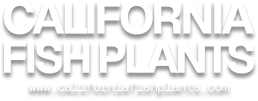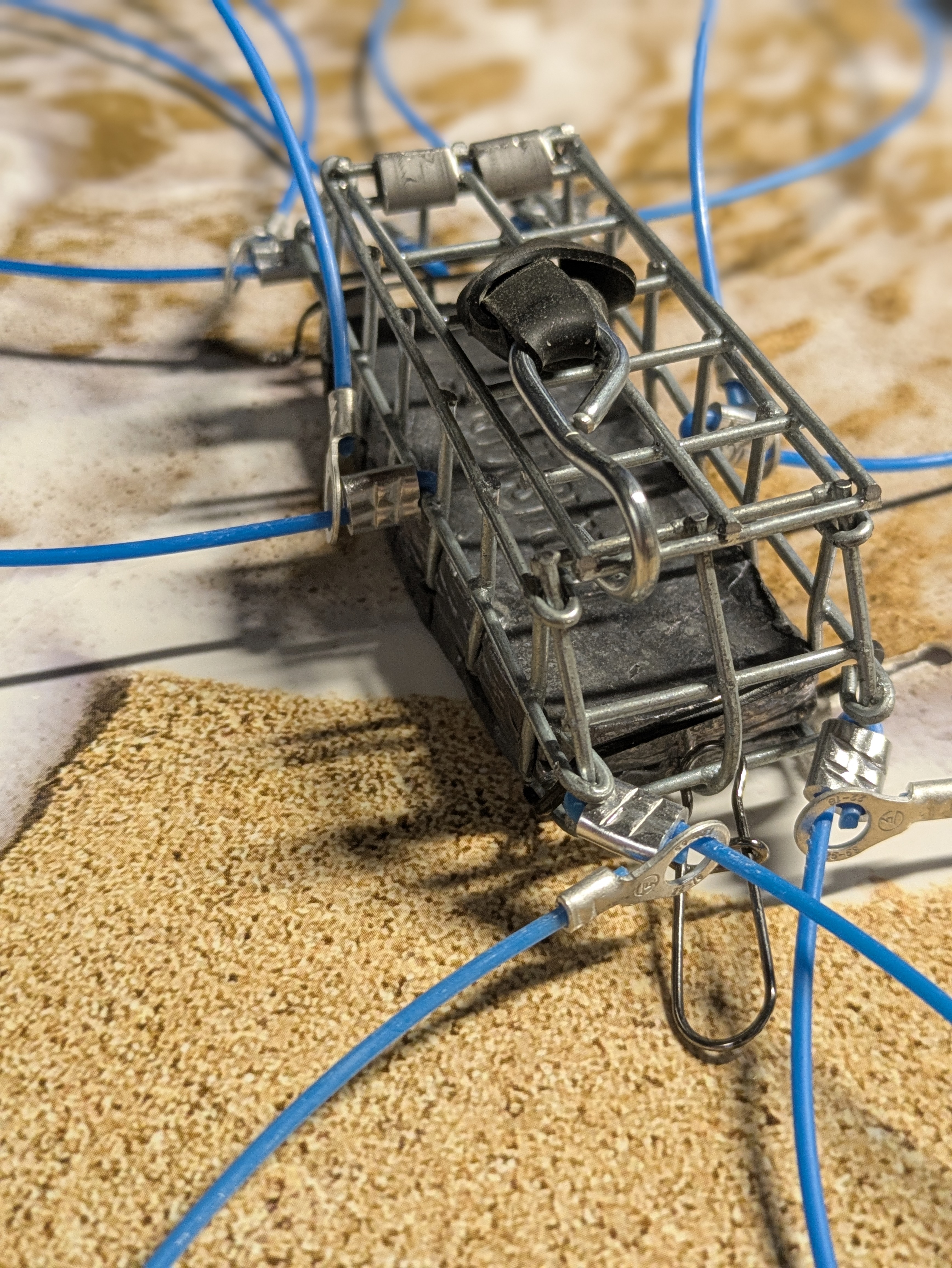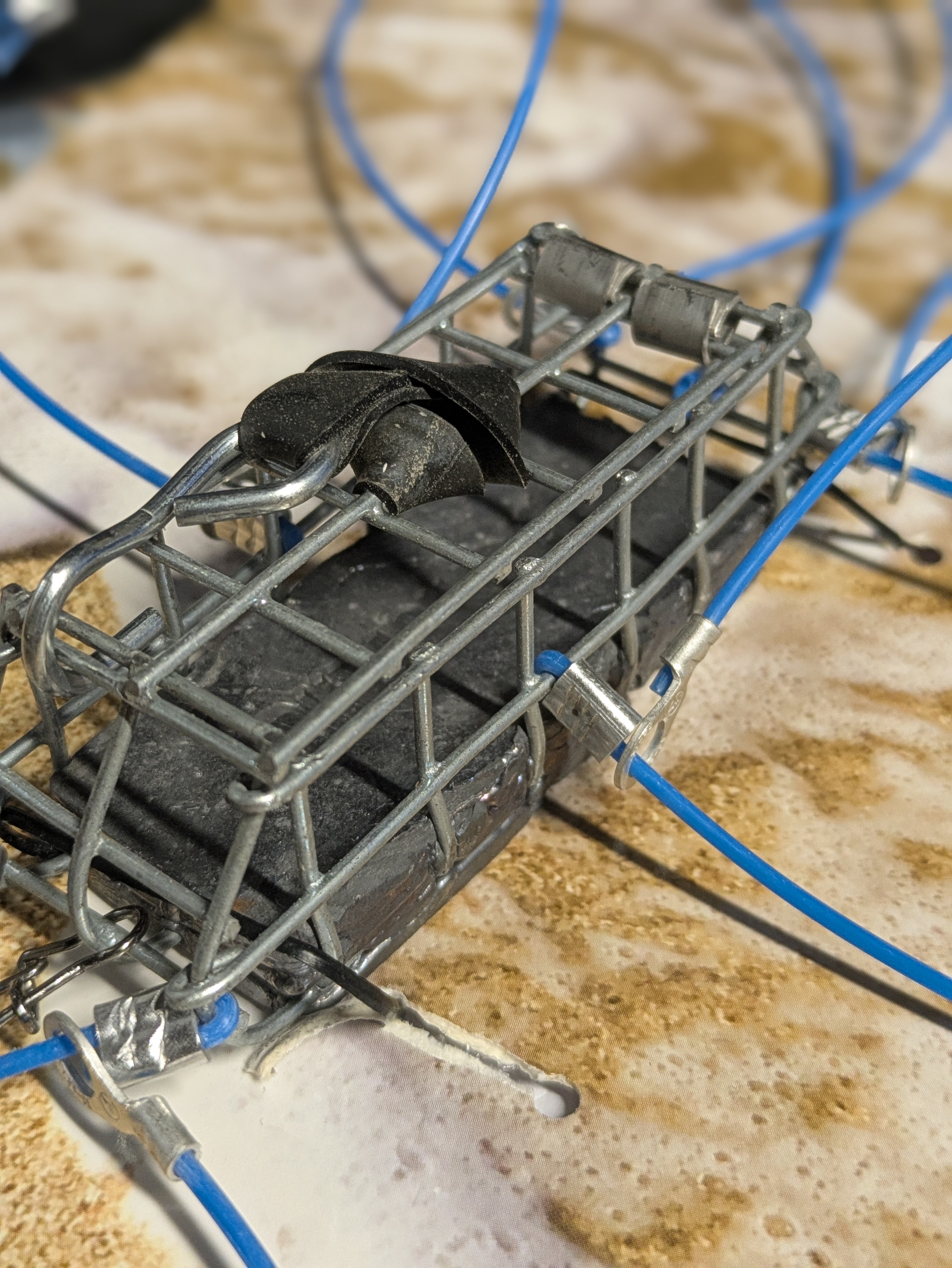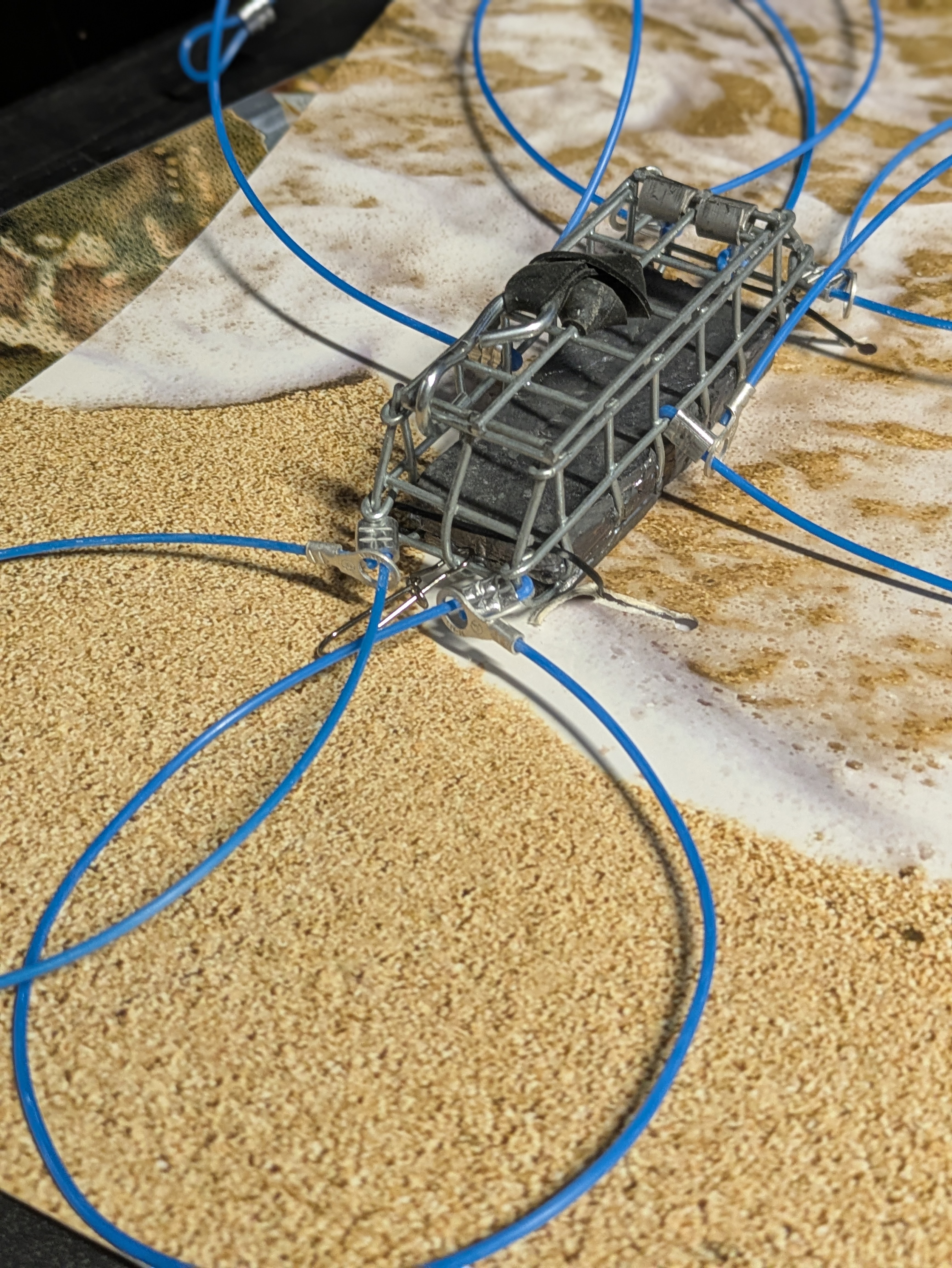2025 California Dungeness Crab
Interactive maps and management regions for California's Dungeness crab fishing
Dungeness Crab Management Regions
California Coast - Six Regional Management Areas
🦀 Welcome to California Dungeness Crabbing
Dungeness crab (Metacarcinus magister) is California's most prized crab species, named after the port of Dungeness, Washington. These delicious crustaceans have been a West Coast tradition since the 1840s, supporting both commercial and recreational fisheries.
Whether you're dropping traps from a boat or snaring from shore, crabbing offers a fun, family-friendly way to harvest your own seafood. This guide will help you get started safely and legally.
🎯 Quick Start Guide
📋 What You Need
- Valid fishing license
- Crab measuring gauge
- Up to 10 traps (from boat)
- Or 6 snares (from shore)
- Bait (fish heads, chicken)
- Bucket for your catch
📏 Size & Limits
- 5¾ inches minimum width
- 10 crabs daily bag limit
- Measure across back shell
- Males only (narrow tail flap)
- Return females & undersized
- No sorting on water
📅 When to Go
- Season varies by region
- Usually Nov/Dec - June/July
- Check for delays/closures
- Best at slack tide
- Early morning ideal
- Avoid rough weather
🦀 Know Your Crabs
Dungeness Crab (Legal to Keep)
How to Identify:
- Purple-brown to gray shell color
- White-tipped claws
- Wide, oval-shaped shell
- 10 legs total (including claws)
- Can grow up to 10 inches wide
Male vs Female:
- Males: Narrow, triangular tail flap (keep these!)
- Females: Wide, rounded tail flap (must release)
- Flip crab over to check tail
- Females may carry orange eggs
🔍 How to Tell Male from Female - The Abdomen Check
The easiest way to determine a crab's sex is by looking at its abdomen (also called the "apron") on the underside. This flap-like structure is located on the belly between the walking legs.
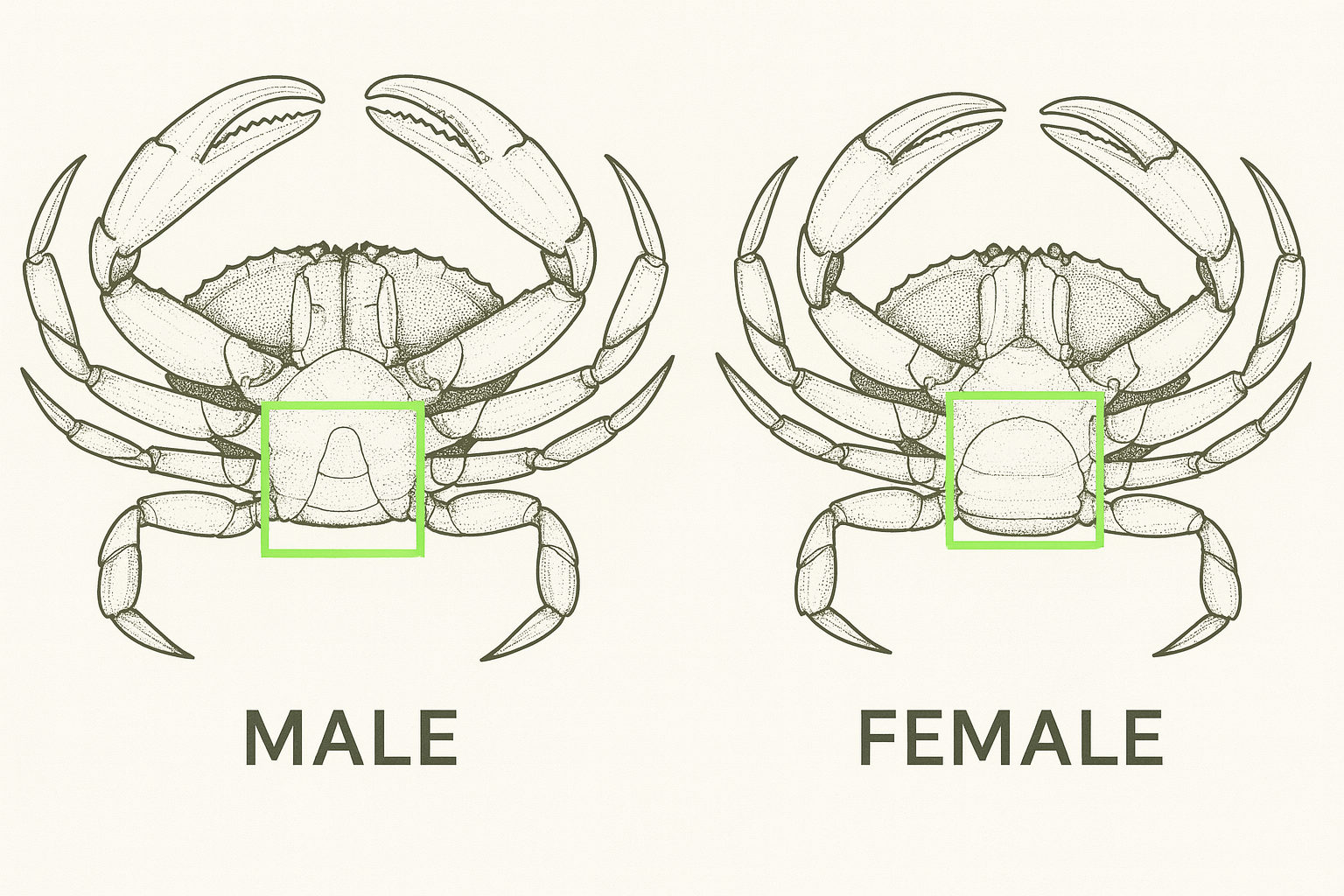
Visual guide: Male (left) has narrow triangular abdomen, Female (right) has wide rounded abdomen
♂️ Male Abdomen
- Narrow and triangular shaped
- Points toward the head
- Often called "lighthouse" shaped
- Tightly folded against body
- ✅ LEGAL TO KEEP
♀️ Female Abdomen
- Wide and rounded (oval)
- Covers most of underside
- Often called "beehive" shaped
- May contain egg mass (sponge)
- ❌ MUST RELEASE
Pro Tip: Simply flip the crab over and look at the underside. The abdomen shape difference is very obvious - think "triangle = take" and "round = release"!
❌ Red Rock Crab (Often Confused)
- Brick red color (obvious difference)
- Black-tipped claws
- Smaller - usually 4-6 inches
- Legal: 4 inches, 35 crab limit
- Less meat but still tasty
- Found in rockier areas
⚠️ European Green Crab (Invasive)
- Green to orange color
- 5 spines beside each eye
- Much smaller - 3 inches max
- Invasive species - destroy if caught
- Do not return to water
- Report sightings to CDFW
🎣 Using Crab Snares
Recommended Gear: Durasnare 8oz
Our go-to crab snare is the Durasnare 8oz, designed by local crab snaring expert Lawrence Ngai, founder of Durasnare. Built specifically for the California Coast, this is currently the best performing snare on the market for shore-based crabbing.
Key Features
- 8oz lead weight for California conditions
- Durable mesh construction
- Optimized hoop diameter
- Quick-close mechanism
- Built for shore deployment
Why It Works
- Designed for California currents
- Proper weight-to-size ratio
- Reliable trigger sensitivity
- Minimal crab escape rate
- Easy bait attachment
Lawrence Ngai's years of California coastal experience show in every aspect of this snare's design. It consistently outperforms generic alternatives in our local conditions.
Basic Setup and Technique
Rod and Line Setup
- Use a 10-12 foot surf rod for proper reach
- 30lb monofilament or 65lb braided line minimum
- Heavy-duty snap swivel at line end
- Medium to large spinning reel (6000-8000 series)
Deployment Process
- Attach snare to snap swivel on your line
- Open snare door and secure bait inside
- Cast out and let it settle on bottom
- Keep slight tension, but allow some slack
Checking Your Snare
Wait 5-10 minutes before your first check. Slowly lift your rod tip and reel in slack until you feel weight. If there's unusual heaviness or resistance, you likely have a crab. Continue reeling steadily but not too fast - you want to keep the crab calm and the snare loops engaged.
Once the snare reaches the surface, grab the frame and lift it clear of the water before releasing the crab.
Best Baits
- Fresh squid (most reliable)
- Anchovies or sardines
- Mackerel chunks
- Fish heads or frames
Care and Storage
- Rinse with warm water after each use
- Store flat with lead weight down
- Keep loops free from overlapping
- Avoid placing weight on the loops
⚠️ Domoic Acid & Safety
What is Domoic Acid?
Domoic acid is a natural toxin produced by certain algae. When crabs eat these algae, the toxin accumulates in their organs (viscera/guts). This is why California often delays crab season - to protect your health!
🛡️ How to Stay Safe:
- Only eat the meat - never eat the guts (viscera)
- Clean thoroughly - remove all internal organs
- Follow advisories - CDFW tests regularly
- When in doubt - stick to leg and claw meat only
- Cooking does NOT destroy the toxin
- Symptoms include vomiting, diarrhea, confusion
📋 Key Regulations Made Simple
🎣 Gear Rules
- From Boat: Max 10 traps
- From Shore: Max 6 snares/nets
- By Hand: SCUBA allowed
- Traps must have escape ports
- Buoys must show your GO ID#
- No traps in navigation channels
- Service traps every 9 days
✅ Best Practices
- Measure every crab immediately
- Release undersized quickly
- Handle crabs gently
- Keep crabs cool and moist
- Don't leave gear unattended
- Respect private property
- Share the pier/dock space
⚠️ Always Check Current Regulations
Crab regulations can change quickly due to domoic acid levels, whale entanglements, or conservation needs. Before each trip, check the latest updates:
- CDFW Crab Hotline: (800) 858-0554
- Website: wildlife.ca.gov/fishing/ocean/dungeness-crab
- Email alerts: Sign up on CDFW website
💡 Disclaimer
This guide provides a simplified overview of Dungeness crab fishing in California for educational purposes. It is not a substitute for official regulations. Rules vary by region and change frequently.
Always consult current CDFW regulations before crabbing. The authors assume no responsibility for violations or accidents resulting from use of this guide. When in doubt, contact CDFW directly.
